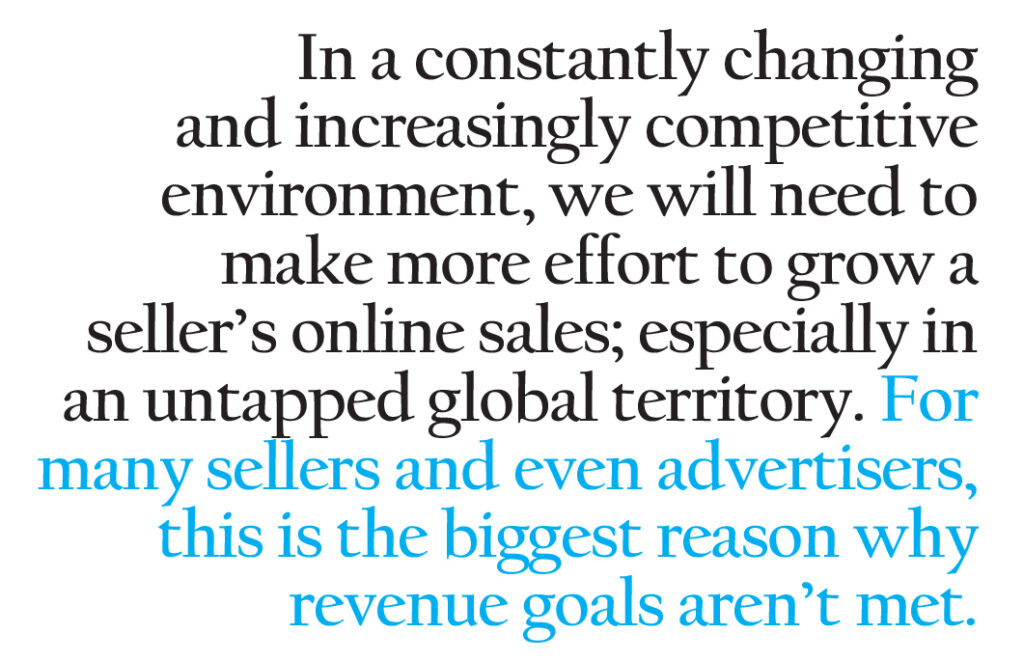The advertising industry in Pakistan is shifting focus to digital marketing in eCommerce, transforming the retail industry, and the way in which sellers need to think about their retail marketing strategies. These days, a savvy and forward-thinking digital marketing strategy is crucial to the success of any retail business – because it is very likely that they have an online presence – especially globally with worldwide shipment processes aligned and enabled.
What the inclusion of Pakistan on the Amazon sellers list does is vastly facilitate sellers with easier payment terms and processes which makes it easy for different countries to access Pakistani products and not worry about credibility or uncertainty of timely shipment.
Digital marketing allows local sellers to reach new customers on Amazon, and in order to catch on to the latest trend, advertising agencies have to focus on these digital marketing strategies and the media industry has to keep a higher percentage of their media budget on digital medium for the brands that will now become sellers on Amazon and serve globally.
At least 80% of digital marketers working in the advertising industry think Facebook is an effective use of resources for small businesses, and it’s easy to see why: social media marketing and paid search have allowed retail sellers to reach more customers than ever before.
While previously the advertising industry would need to rely on persuading customers to go to their clients’ physical store locations as a basis for their marketing efforts, today customer geography is spread out over a much wider area, and now with Amazon, even on a global scale. Because the pool of potential customers is larger, there’s also a need for more precise targeting via channels such as paid search and social media to ensure leads are of high quality.
Advertisers and sellers should always put the customer first.
The proliferation of eCommerce trading means that customers can more easily shop around to find the best value. With customer loyalty and repeat business being harder to obtain, ATL agencies need to be smarter in utilizing channels such as social media to directly connect with customers and provide personalized responses and service – therefore the advertising industry needs to have an IMC approach for all their campaign ideas.
This means there should not be segregation of ATL/BTL and digital; every agency should offer fluid services to give meaning to the seller’s brand’s unique selling proposition. A customers’ purchasing behavior is also being driven less by advertising and more by word-of-mouth recommendations. In a recent study, 67% of consumers said that online reviews were “fairly, very or absolutely important” to their online buying decisions.

In another survey, 45% of respondents aged 18 and older said that reading reviews, comments, and feedback on social media influenced their online shopping decisions. Advertisers now need to consider surfacing customer-generated feedback like positive reviews and testimonials through online channels, as a complement to more traditional marketing efforts.
Digital marketing for Amazon sellers has had a significant positive impact on SME retail advertisers – smaller businesses are now able to compete with large companies in terms of customer reach online and driving leads. Similarly, online inventory management systems have also allowed eCommerce SMEs to streamline operations and stock management, making the buying cycle more efficient.
However, as the demand for personalized customer experiences grows, small-to-medium sellers need to better utilize data and analytics to understand their global customers’ habits, preferences, and needs. In a recent report, 48% of SMEs said they didn’t know whether their digital marketing efforts were effective.
It is clear that there’s a need for smaller eCommerce sellers to be more diligent about defining their marketing objectives and measuring their results rather than just registering themselves with Amazon and not be able to deliver the desired results – this is where the advertising and media industry shifts and offers more relevant services and media plans.
E-commerce marketing will require the advertising industry to regulate the practice of driving top-of-funnel traffic to convert into sales and customers. And there are hundreds of ways to go about it. From focusing on organic traffic and SEO to using Facebook or Google ads to drive targeted traffic, advertisers can mix and match paid strategies with non-paid strategies all in an effort to figure out which mix converts the most people and makes it stay relevant for sellers of Amazon.
As marketing tactics and marketplace algorithms evolve, so too must the industry’s strategy in order to win the highest return on ad spend – as well as return on operating costs associated with non-paid growth strategies like SEO. You may have once heard: “If you build it, they will come.” It’s a great quote, from a great movie. Unfortunately, when it comes to eCommerce marketing, this notion is completely false. When you build it, they don’t necessarily come.
In a constantly changing and increasingly competitive environment, we will need to make more effort to grow a seller’s online sales; especially in an untapped global territory. For many sellers and even advertisers, this is the biggest reason why revenue goals aren’t met. Unless a seller is pounding the pavement to build awareness, his eCommerce presence on Amazon will exist in a vacuum. And that’s not good for anybody – the seller and the people who want to buy his products.
In order to effectively grow an eCommerce business – whether or not the seller has a retail presence – he will require a well-thought-out eCommerce marketing plan to drive brand awareness and increase sales. And there’s no way around it. Amazon offers Amazon Advertising to help sellers grow their business in the countries they are selling their products as well. But how would a Pakistani seller effectively partner with Amazon and use their advertising portal?

Many advertisers have a media budget dedicated to both linear and connected TV. However, because of Amazon’s history as an eCommerce website, many forget to include Amazon in their connected TV buys. Amazon just surpassed Roku with its number of OTT video service users in the US at 96.5 million, so the pool of potential customers is large. Activating OTT is a way to scale your connected TV and tap into Amazon’s first-party data to reach new audiences and develop the seller’s brand.
“A failure to plan is a plan to fail.” Another valid quote. This time, by Benjamin Franklin. To be clear, there’s no shortage of literature around “how to adapt to the ever-changing marketing needs.” In fact, that topic keeps many authors, teachers, and high-priced public speakers employed. And justifiably so. Many tried and true principles remain relevant today, but with the continued evolution of eCommerce, this isn’t the time to get complacent.
Without a well-thought-out plan of attack, the chances of accomplishing the seller’s marketing goals will be slim to none. And without an understanding of the Amazon marketing landscape, they are at a severe disadvantage. A seller would have to seek out mentors and advice. Find agencies or individual advertisers who have already built and scaled a successful eCommerce business, ideally within the same industry. Then, ask for their advice.
- How did they get started?
- What marketing channels produced the biggest ROI in the short term?
- What technology did they use to track data?
The advertising industry as a whole has to outline a roadmap for growth. Make goals and objectives very clear and specific. Once the agency begins to execute, there’s no shame in amending the goals if they turned out to be too low or too high. Eventually, the primary focus should be creating realistic, attainable goals. And then, layering in “stretch goals” to really excite the sellers. That being said, the media industry must make sure to include specific goals and metrics, such as:
- Increase sales by X% during the slow season.
- Increase AOV by X% on Black Friday & Cyber Monday.
- Increase email marketing conversion rates by X%.
Can the advertising industry target customers, personas & markets? Only by knowing the global audience. If we don’t have a clear understanding of who we are targeting, what characteristics define them, and where they’re located — we are bound to run inefficient campaigns that waste money targeting low-converting, unqualified individuals. We have to know the following:
- Age ranges.
- Gender breakdown.
- Geographic location.
- Purchasing power.
“You can only know where you’re going if you know where you’ve been.” Therefore, advertisers need to perform a thorough assessment of the current state of the company, the competition, and the overall marketing plan. Leave no stone unturned. A better understanding of the current situation will lead to better decision-making, and eventually, better results. Ensure the pricing and positioning provides real value to the target audience.
Forcing products upon your target customers that they deem to be overpriced is a losing proposition, especially when price comparing is SO easy these days. Therefore, we as an industry need to do our research and equip our sellers accordingly. Of course, there are opportunities for testing and refinement throughout their product’s lifecycle, but by doing a little more work upfront, we will be better off in the long run.
Even if we are starting small currently, we should have a clear understanding of the distribution and order fulfillment requirements that will evolve as the seller grows in a foreign market. Whether the seller is packing and shipping himself, overseeing a small team, or leveraging a third-party fulfillment shop, he needs to know whether his fulfillment processes can meet the demand of his upcoming marketing push.
Therefore, we can say that our sellers being added to the Amazon sellers’ list globally is a positive sign – how it affects the advertising or media industry is in more ways a positive wake-up call for agencies to change with changing times and shift focus towards building an e-commerce marketing strategy empire, equipping the local sellers to compete in a global market with same advertising skills.
Sellers are not going to be successful without the backing of solid media and advertising strategies which can only be generated through an adaptable advertising industry on a whole.
























Very nice useful article! Bravo and keep it up Sehar!